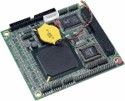Low-power PCI-104 SBC supports Linux
December 22, 2006 Acrosser is shipping a new PCI-104 SBC (single-board computer) based on a low-power AMD Geode LX800 processor. The AR-B1622 is supported with drivers for Linux, and targets space-constrained, fanless designs such as portable medical equipment, according to the company. (more…)
Acrosser is shipping a new PCI-104 SBC (single-board computer) based on a low-power AMD Geode LX800 processor. The AR-B1622 is supported with drivers for Linux, and targets space-constrained, fanless designs such as portable medical equipment, according to the company. (more…)
 As 2006 winds to a close, the editors of LinuxDevices.com have assembled a retrospective aimed at highlighting major trends and events in the world of embedded Linux. Of the approximately 1,200 stories we published this year, these were the most important, in our opinion.
As 2006 winds to a close, the editors of LinuxDevices.com have assembled a retrospective aimed at highlighting major trends and events in the world of embedded Linux. Of the approximately 1,200 stories we published this year, these were the most important, in our opinion.  Bitsim is shipping an evaluation and development board that targets 2D graphics-intensive embedded applications, such as instrumentation and gaming devices. The “Badger” board is based on an ARM9 processor and Altera Cyclone II FPGA (field-programmable gate array), and apparently is accelerated by Bitsim's “Badge” softcore…
Bitsim is shipping an evaluation and development board that targets 2D graphics-intensive embedded applications, such as instrumentation and gaming devices. The “Badger” board is based on an ARM9 processor and Altera Cyclone II FPGA (field-programmable gate array), and apparently is accelerated by Bitsim's “Badge” softcore…  Neuros Audio's tiny Linux-based DVR (digital video recorder) has lots of potential, if community enthusiasm continues, according to an online review. The “Open Source Device” (OSD) is already capable enough for users simply wishing to record or transcode TV for playback on handheld devices,…
Neuros Audio's tiny Linux-based DVR (digital video recorder) has lots of potential, if community enthusiasm continues, according to an online review. The “Open Source Device” (OSD) is already capable enough for users simply wishing to record or transcode TV for playback on handheld devices,…  Sasken Communication Technologies says its multimedia application/codec stack was licensed by Wistron NeWeb Corp. (WNC) for several Linux mobile phones due in early 2007. The phones will run Sasken's “Multimedia Subsystem Solution” (MSS) stack on a MontaVista Linux kernel and TI OMAP application…
Sasken Communication Technologies says its multimedia application/codec stack was licensed by Wistron NeWeb Corp. (WNC) for several Linux mobile phones due in early 2007. The phones will run Sasken's “Multimedia Subsystem Solution” (MSS) stack on a MontaVista Linux kernel and TI OMAP application…  Eurotech says it will embed IBM's Lotus Mobile Connect software into its “NanoPC” range of devices, including embedded PCs, network appliances, and wearable PCs such as the Zypad wrist-worn PC (shown here). IBM's Lotus Mobile Connect enables devices to maintain application connectivity while roaming disparate networks, Eurotech says.
Eurotech says it will embed IBM's Lotus Mobile Connect software into its “NanoPC” range of devices, including embedded PCs, network appliances, and wearable PCs such as the Zypad wrist-worn PC (shown here). IBM's Lotus Mobile Connect enables devices to maintain application connectivity while roaming disparate networks, Eurotech says.  Asian Linux distributor TurboLinux is readying an iPod-like like device that doubles as a Linux boot drive. The “Wizpy” media player, set to ship in Japan in February, enables users to take their Linux with them, for added convenience, security, and privacy, the company says.
Asian Linux distributor TurboLinux is readying an iPod-like like device that doubles as a Linux boot drive. The “Wizpy” media player, set to ship in Japan in February, enables users to take their Linux with them, for added convenience, security, and privacy, the company says.  Linux was shot into space Dec. 16, as part of a second-phase Air Force Research Laboratory program aimed at making space more “operationally responsive.” The TacSat-2 (tactical satellite) program aims to create “micro satellites” that can be launched quickly and cheaply, to support tactical military operations.
Linux was shot into space Dec. 16, as part of a second-phase Air Force Research Laboratory program aimed at making space more “operationally responsive.” The TacSat-2 (tactical satellite) program aims to create “micro satellites” that can be launched quickly and cheaply, to support tactical military operations.